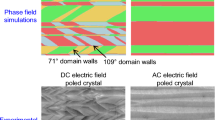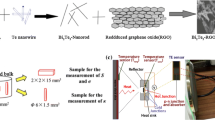Abstract
For the first time, we have demonstrated the control of the sign and magnitude of the second-order optical nonlinearity (SON) of thermally poled soda-lime glasses with a DC voltage applied to the glass at room temperature. We called this procedure “cold re-poling”. The sign inversion of SON can be provided by a voltage opposite in sign to the one used in thermal poling. Regardless of the sign of cold re-poling voltage, it results in up to tenfold increase in the intensity of the second optical harmonic generated by thermally poled glasses. Moreover, cold re-poling makes it possible to restore and increase the SON of poled glasses degraded after thermal treatment, even if the treatment temperature exceeded 400 °C. The cold re-poling process is relatively slow and takes about ~ 2000s. This time correlates with characteristic time of charging/recharging of a capacitor in RC-circuit, which is represented by the poled region of a glass.





Similar content being viewed by others
Data and code availability
Not applicable.
References
Lepicard A, Bondu F, Kang M et al (2018) Long-lived monolithic micro-optics for multispectral GRIN applications. Sci Rep 8:7388–7396. https://doi.org/10.1038/s41598-018-25481-x
Fabijanić I, Pervan P, Okorn B et al (2020) Ellipsometry-based study of glass refractive index depth profiles obtained by applying different poling conditions. Appl Opt 59:A69–A74. https://doi.org/10.1364/AO.59.000A69
Kamenskii AN, Reduto IV, Petrikov VD, Lipovskii AA (2016) Effective diffraction gratings via acidic etching of thermally poled glass. Opt Mater 62:250–254. https://doi.org/10.1016/j.optmat.2016.09.074
He H, Luo J, Qian L et al (2016) Thermal poling of soda-lime silica glass with nonblocking electrodes—part 2: effects on mechanical and mechanochemical properties. J Am Ceram Soc 99:1231–1238. https://doi.org/10.1111/jace.14080
Lipovskii A, Zhurikhina V, Tagantsev D (2017) 2D-structuring of glasses via thermal poling: a short review. Int J Appl Glass Sci 9:24–28. https://doi.org/10.1111/ijag.12273
Lubyankina EA, Raskhodchikov DV, Babich ES et al (2021) Peculiarities of ion-exchange in poled glasses. J Phys Conf Ser 2086:012152. https://doi.org/10.1088/1742-6596/2086/1/012152
Beresna M, Kazansky PG, Deparis O et al (2010) Poling-assisted fabrication of plasmonic nanocomposite devices in glass. Adv Mater 22:4368–4372. https://doi.org/10.1002/adma.201001222
Zhurikhina VV, Brunkov PN, Melehin VG et al (2012) Self-assembled silver nanoislands formed on glass surface via out-diffusion for multiple usages in SERS applications. Nanoscale Res Lett 7:676–681. https://doi.org/10.1186/1556-276X-7-676
Lipovskii AA, Melehin VG, Petrikov VD (2006) Electric-field-induced bleaching of ion-exchanged glasses containing copper nanoparticles. Tech Phys Lett 32:275–277. https://doi.org/10.1134/S1063785006030308
Russell PS, Pannell CN, Kazansky PG, Dong L (1995) Pockels effect in thermally poled silica optical fibres. Electron Lett 31:62–63. https://doi.org/10.1049/el:19950036
Myers RA, Mukherjee N, Brueck SRJ (1991) Large second-order nonlinearity in poled fused silica. Opt Lett 16:1732–1734. https://doi.org/10.1364/OL.16.001732
Mukherjee N, Myers RA, Brueck SRJ (1994) Dynamics of second-harmonic generation in fused silica
Lasbrugnas C, Thomas P, Masson O et al (2009) Second harmonic generation of thermally poled tungsten tellurite glass. Opt Mater 31:775–780. https://doi.org/10.1016/j.optmat.2008.08.002
Liu Q, Gao C, Li H, Zhao X (2009) The generation and stability of second-harmonic in electron-beam irradiated GeS2–In2S3–CdS chalcogenide glasses. Solid State Commun 149:266–268. https://doi.org/10.1016/j.ssc.2008.12.011
Shivachev BL, Petrov T, Yoneda H et al (2009) Synthesis and nonlinear optical properties of TeO2–Bi2O3–GeO2 glasses. Scr Mater 61:493–496. https://doi.org/10.1016/j.scriptamat.2009.05.006
Qiu M, Pi F, Orriols G, Bibiche M (1998) Signal damping of second-harmonic generation in poled soda-lime silicate glass. J Opt Soc Am B 15:1362–1365. https://doi.org/10.1364/JOSAB.15.001362
Guillet de Chatellus H, Freysz E (2001) Measurement of the third-order susceptibility of glasses by EFISH of femtosecond pulses. Opt Express 9:586–591. https://doi.org/10.1364/OE.9.000586
Reshetov I, Scherbak S, Tagantsev D et al (2022) Giant enhancement of optical second harmonic in poled glasses by cold repoling. J Phys Chem Lett 13:5932–5937. https://doi.org/10.1021/acs.jpclett.2c01440
Chen H-Y, Lin H-Y (2019) Thermal poling induced second-order optical nonlinearity in phosphosilicate glass thin films. J Mod Opt 66:2053–2062. https://doi.org/10.1080/09500340.2019.1691276
Le Calvez A, Freysz E, Ducasse A (1998) A model for second harmonic generation in poled glasses. Eur Phys J D At Mol Opt Phys 1:223–226. https://doi.org/10.1007/s100530050084
Reshetov I, Kaasik V, Kan G et al (2022) SHG in micron-scale layers of glasses: electron beam irradiation vs. thermal poling. Photonics 9:733–744. https://doi.org/10.3390/photonics9100733
Yudistira D, Faccio D, Corbari C et al (2008) Electric surface potential and frozen-in field direct measurements in thermally poled silica. Appl Phys Lett 92:012912. https://doi.org/10.1063/1.2827175
Dussauze M, Rodriguez V, Adamietz F et al (2016) Accurate second harmonic generation microimprinting in glassy oxide materials. Adv Opt Mater 4:929–935. https://doi.org/10.1002/adom.201500759
Zhang S, Yao J, Liu W et al (2008) Second harmonic generation of periodically poled potassium titanyl phosphate waveguide using femtosecond laser pulses. Opt Express 16:14180–14185. https://doi.org/10.1364/OE.16.014180
Niu Y, Yan X, Chen J et al (2022) Research progress on periodically poled lithium niobate for nonlinear frequency conversion. Infrared Phys Technol 125:104243. https://doi.org/10.1016/j.infrared.2022.104243
Agar Scientific (2023) Microscope slides. https://www.agarscientific.com/fr/high-quality-microscope-slides. Accessed 22 Feb 2023
Scherbak SA, Kaasik VP, Zhurikhina VV, Lipovskii AA (2022) Poling of glasses using resistive barrier discharge plasma. Materials 15:8620–8630. https://doi.org/10.3390/ma15238620
Luo J, He H, Podraza NJ et al (2016) Thermal poling of soda-lime silica glass with nonblocking electrodes—part 1: effects of sodium ion migration and water ingress on glass surface structure. J Am Ceram Soc 99:1221–1230. https://doi.org/10.1111/jace.14081
Reshetov IV, Kaasik VP, Lipovskii AA, Tagantsev DK (2020) To the issue of the second harmonic generation in poled silicate glasses. J Phys Conf Ser 1695:012131. https://doi.org/10.1088/1742-6596/1695/1/012131
Luo J, Huynh H, Pantano CG, Kim SH (2016) Hydrothermal reactions of soda lime silica glass—revealing subsurface damage and alteration of mechanical properties and chemical structure of glass surfaces. J Non Cryst Solids 452:93–101. https://doi.org/10.1016/j.jnoncrysol.2016.08.021
Jerphagnon J, Kurtz SK (1970) Maker fringes: a detailed comparison of theory and experiment for isotropic and uniaxial crystals. J Appl Phys 41:1667–1681. https://doi.org/10.1063/1.1659090
Scherbak SA, Kaasik VP, Zhurikhina VV, Lipovskii AA (2021) SEM-visualization of a spatial charge and a giant potassium peak in a corona-poled glass. J Phys Condens Matter 33:235702. https://doi.org/10.1088/1361-648X/abf383
Dell JM, Joyce MJ, Stone GO (1994) Erasure of poling-induced second-order optical nonlinearities in silica by UV exposure. SPIE 2289:185–193. https://doi.org/10.1117/12.188711
Nasu H, Okamoto H, Kurachi K et al (1995) Second-harmonic generation from electrically poled SiO2 glasses: effects of OH concentration, defects, and poling conditions. J Opt Soc Am B 12:644–649. https://doi.org/10.1364/JOSAB.12.000644
Imai H, Horinouchi S, Asakuma N et al (1998) Effects of introduction of sodium and water on second-order nonlinearity in poled synthetic silica glass. J Appl Phys 84:5415–5418. https://doi.org/10.1063/1.368795
Wada N, Morinaga K, Takebe H et al (1997) Effect of minority species on thermal poling of fused silica glasses. In: Bragg gratings, photosensitivity, and poling in glass fibers and waveguides: applications and fundamentals. Optica Publishing Group, Washington, p BTuC.3
Doremus RH (2005) Mechanism of electrical polarization of silica glass. Appl Phys Lett 87:1–2. https://doi.org/10.1063/1.2140090
Dussauze M, Rodriguez V, Lipovskii A et al (2010) How does thermal poling affect the structure of soda-lime glass? J Phys Chem C 114:12754–12759. https://doi.org/10.1021/jp1033905
Lepicard A, Cardinal T, Fargin E et al (2016) Micro-structuring the surface reactivity of a borosilicate glass via thermal poling. Chem Phys Lett 664:10–15. https://doi.org/10.1016/j.cplett.2016.09.077
Redkov A, Kaasik V, Melehin V, Lipovskii A (2021) Modification of soda-lime silicate glass under corona poling in air and nitrogen atmosphere. J Non Cryst Solids 554:120599. https://doi.org/10.1016/j.jnoncrysol.2020.120599
Davis KM, Tomozawa M (1996) An infrared spectroscopic study of water-related species in silica glasses. J Non Cryst Solids 201:177–198. https://doi.org/10.1016/0022-3093(95)00631-1
Efimov AM, Pogareva VG, Shashkin AV (2003) Water-related bands in the IR absorption spectra of silicate glasses. J Non Cryst Solids 332:93–114. https://doi.org/10.1016/j.jnoncrysol.2003.09.020
Ngo D, Liu H, Chen Z et al (2020) Hydrogen bonding interactions of H2O and SiOH on a boroaluminosilicate glass corroded in aqueous solution. Npj Mater Degrad 4:1–5. https://doi.org/10.1038/s41529-019-0105-2
Amma S, Kim SH, Pantano CG (2016) Analysis of water and hydroxyl species in soda lime glass surfaces using attenuated total reflection (ATR)-IR spectroscopy. J Am Ceram Soc 99:128–134. https://doi.org/10.1111/jace.13856
Doremus RH (1964) Exchange and diffusion of ions in glass. J Phys Chem 68:2212–2218. https://doi.org/10.1021/j100790a031
Quiquempois Y, Kudlinski A, Martinelli G et al (2005) Near-surface modification of the third-order nonlinear susceptibility in thermally poled InfrasilTM glasses. Appl Phys Lett 86:181106–181167. https://doi.org/10.1063/1.1921348
Qiu M, Mizunami T, Takagaki Y (1999) Second-harmonic generation from the cathode-side face in a poled glass. SPIE Proc 3793:163–170. https://doi.org/10.1117/12.351411
Qiu M, Mizunami T, Takagaki Y et al (1999) Study of the second-order susceptibility from the cathode-side face of poled glasses. J Non Cryst Solids 255:250–253. https://doi.org/10.1016/S0022-3093(99)00480-9
Cassidy A, Jørgensen MRV, Glavic A et al (2021) A mechanism for ageing in a deeply supercooled molecular glass. Chem Commun 57:6368–6371. https://doi.org/10.1039/D1CC01639C
Okada K, Yao M, Hiejima Y et al (1999) Dielectric relaxation of water and heavy water in the whole fluid phase. J Chem Phys 110:3026–3036. https://doi.org/10.1063/1.477897
Penninck L, Steinbacher F, Krause R, Neyts K (2012) Determining emissive dipole orientation in organic light emitting devices by decay time measurement. Org Electron 13:3079–3084. https://doi.org/10.1016/j.orgel.2012.09.014
Ko IJ, Lee H, Park JH et al (2019) An accurate measurement of the dipole orientation in various organic semiconductor films using photoluminescence exciton decay analysis. Phys Chem Chem Phys 21:7083–7089. https://doi.org/10.1039/C9CP00965E
Johari GP, Jones SJ (1978) The orientation polarization in hexagonal ice parallel and perpendicular to the c-axis. J Glaciol 21:259–276. https://doi.org/10.3189/S0022143000033463
Roth TA (1971) Dielectric relaxation of ZnF 2:LiF and its crystallographic orientation dependence. J Appl Phys 42:246–249. https://doi.org/10.1063/1.1659575
Fokine M, Ferraris M, Carvalho ICS (2007) Thermal poling of glass—a nonlinear ionic RC circuit. In: Bragg gratings, photosensitivity, and poling in glass waveguides. OSA, Washington, p JWBPDP6
Koroleva E, Reshetov I, Babich E et al (2022) Peculiar electric properties of polarized layer in alkaline silicate glasses. J Am Ceram Soc 105:3418–3427. https://doi.org/10.1111/jace.18324
Vu TTN, Teyssedre G, Le RS, Laurent C (2017) Maxwell-Wagner effect in multi-layered dielectrics: interfacial charge measurement and modelling. Technologies 5:27–42. https://doi.org/10.3390/technologies5020027
Mehrer H (2016) Diffusion and ion conduction in cation-conducting oxide glasses. Diffus Found 6:59–106. https://doi.org/10.4028/www.scientific.net/DF.6.59
Acknowledgements
The authors are grateful to the Ministry of Science and Higher Education of Russian Federation for supporting research within the FSRM-2023-009 project.
Author information
Authors and Affiliations
Contributions
AL contributed to conceptualization; VK contributed to methodology; OP contributed to software; SS contributed to formal analysis; IR and GK contributed to investigation; AL contributed to writing—original draft preparation; AL and VM contributed to writing—review and editing.
Corresponding author
Ethics declarations
Conflict of interest
The authors declare no conflict of interest.
Ethical approval
Not applicable.
Additional information
Handling Editor: Catalin Croitoru.
Publisher's Note
Springer Nature remains neutral with regard to jurisdictional claims in published maps and institutional affiliations.
Rights and permissions
Springer Nature or its licensor (e.g. a society or other partner) holds exclusive rights to this article under a publishing agreement with the author(s) or other rightsholder(s); author self-archiving of the accepted manuscript version of this article is solely governed by the terms of such publishing agreement and applicable law.
About this article
Cite this article
Reshetov, I., Scherbak, S., Kan, G. et al. Controlling the sign and magnitude of the nonlinear susceptibility of poled glasses at room temperature. J Mater Sci 58, 11859–11871 (2023). https://doi.org/10.1007/s10853-023-08729-4
Received:
Accepted:
Published:
Issue Date:
DOI: https://doi.org/10.1007/s10853-023-08729-4




